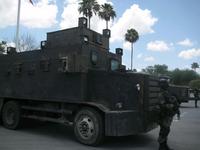-
Mexican drug cartels build "narco tanks"

In the latest development in Mexico’s bloody drug trade, it seems that rival cartels are building large armored vehicles in their fight against one another; over the weekend, the Mexican Army found two “Mad Max” style “narco tanks” in Ciudad Camargo in the state of Tamaulipas near the Texas border; the two vehicles had inch-thick steel armor and were built on a three-axle truck bed with a heavily armored cabin; the vehicles were capable of withstanding fire from 50 caliber mounted weapons and grenade blasts; so far none of the tanks have been used to confront the Mexican Army and officials believe that they are primarily used in inter-gang warfare
-
-
Middlesex County, N.J. gets $1 million for mobile tent system
Local emergency responders in New Jersey recently received a big boost in disaster preparedness from DHS; last week the county unveiled a new 3,000 square foot mobile structure comprised of interlocking tents and trailers; the tents can be quickly set up to treat victims of a radiological accident, terrorist attack, pandemic, or weather emergency; the tent system can also be outfitted with its own water supply, power generator, and heating and cooling systems. They are even equipped with lights, showers, sinks, and a kitchen; for training purposes, the tents were set up at the Middlesex County College campus; the portable structure, called the Gatekeeper system, cost $1 million and was paid for with DHS grant money; county officials also received DHS grants to purchase mobile radiation detection devices for police officers; the tents and the radiation detectors come as part of a broader government effort to prepare local law enforcement agencies within a forty-five mile radius of New York City for a dirty-bomb attack
-
-
Police cruiser equipped with streaming video cameras
To showcase the potential of streaming high-definition cameras, Axis Communications, a Swedish video technology firm, has built a sophisticated prototype police cruiser outfitted with the latest video equipment; the prototype cruiser is equipped with five high-definition video cameras which can allow officers at a command center or even in another police cruiser to monitor events via a live feed over a 4G wireless Internet connection; in the cruiser’s trunk is a network video recorder which functions as both a server to stream video to a cloud network as well as a central repository for the video feeds
-
-
Analytic software analyzes every word of 911 calls

Emergency 911 calls contain valuable data, but investigators and call centers have lacked the manpower or resources to manually analyze each call, however speech analysis software has greatly simplified this task; with speech analytics, law enforcement officials and call centers can now automatically pour through thousands of call records to spot developing trends, assist in ongoing investigations, and identify best practices; the software is capable of indexing every word and phrase in a database, so investigators can run comprehensive searches on various 911 calls
-
-
Floyd County gets additional $75,000 for CBRNE unit
Floyd County in Georgia has received two DHS grants worth $75,000 to replace and repair equipment for its chemical, biological, radiological, nuclear, and explosives (CBRNE) response unit; the bulk of the money, approximately $65,000, will go towards replacing aging equipment, while the rest will go towards repairs; the CBRNE team was originally created four years ago with nearly $350,000 in DHS funding as part of the state’s terrorism prevention initiative
-
-
Local police in Ohio create joint computer forensics squad
Last week in Ohio, officials from three law enforcement agencies announced the creation of a joint multijurisdictional technology crimes task force; the new squad will be responsible for a range of crimes including digital identity theft, child pornography, as well as traditional crimes; with the increasing ubiquity of smartphones and laptops, criminals now leave a trail of digital evidence and investigators must be able to properly process this evidence without corrupting the data; officials hope that the new joint task force will allow the departments to share expertise, conduct training, and win state and federal grants
-
-
Police cruiser equipped with streaming video cameras
To showcase the potential of streaming high-definition cameras, Axis Communications, a Swedish video technology firm, has built a sophisticated prototype police cruiser outfitted with the latest video equipment; the prototype cruiser is equipped with five high-definition video cameras which can allow officers at a command center or even in another police cruiser to monitor events via a live feed over a 4G wireless Internet connection; in the cruiser’s trunk is a network video recorder which functions as both a server to stream video to a cloud network as well as a central repository for the video feeds
-
-
Sensors detect the crime-solving clues at our fingertips
A new approach to fingerprinting using sensor technology developed at the University of Sussex could soon be helping forensics teams date and identify prints left at a crime scene — by capturing their electrical imprint; traditional methods of fingerprinting do not allow forensics experts to differentiate between prints at a crime scene left before and after the crime has been committed, or to differentiate important or interesting prints from background “clutter”; the new method offers a solution
-
-
Grand Junction, Colorado uses DHS grant to purchase bomb squad equipment
The Grand Junction Police Department in Colorado recently received two grants to purchase sophisticated new equipment for its bomb squad and new information sharing software; on Monday, the city council authorized the police department to accept the two grants; thanks to a $250,000 grant from DHS, the police department will now be able to purchase a Total Containment Vessel (TCV); Grand Junction also received a $108,000 grant from the Colorado Association of Chiefs of Police to purchase new software
-
-
New York ICE agent arrested for stealing and selling government property
A special agent with the Immigration and Customs Enforcement (ICE) agency was recently arrested on Tuesday for allegedly stealing government property and then selling it on eBay; the agent, Steven Kucan, was a resident of Wood Ridge, New Jersey and will appear in a federal court in Newark, New Jersey; Kucan reportedly sold approximately $37,000 worth of ICE property using an eBay account that was opened in the name of an elderly relative; stolen items include printer cartridges, camera lenses, film, combat lights for M-4 rifles, and even a special diving suit designed to prevent hypothermia in cold water
-
-
A team of robots collaborate in exploration, map building
Researchers have developed an advanced autonomous capability for first responders, law enforcement, and the military: a group of robots, working by themselves and communicating only with one another, divide up among themselves a variety of exploration tasks — for example, they can go into a building and within minutes transmit a detailed floor map to humans waiting at a command center nearby
-
-
Infrared sensors could help police detect suicide vests
Sophisticated infrared sensors originally designed for the U.S. military could soon be used by local police departments to detect suicide bombers; Thermal Matrix USA initially designed its Access Counter IED Technology system to assist military personnel in Iraq and Afghanistan identify potential suicide bombers, but hopes to create a model that local law enforcement agencies can deploy; the company has modified its product to significantly reduce its size, weight, and deployment time to be more practical; the devices are capable of detecting any hidden objects including knives, guns, plastics, and even liquids
-
-
States turning to new "familial DNA" tests, practice faces legal hurdles
Law enforcement officials in several states across the United States are hoping to obtain the legal authority to begin conducting “familial DNA” testing, a process which could greatly increase the number of suspects identified in violent crimes; while DNA is often found at crime scenes using familial DNA would allow law enforcement officials to use DNA from a suspected criminal’s relatives to positively identify them; currently only California and Texas have laws in place that allow investigators to conduct familial DNA tests; Virginia, Pennsylvania, and Florida could soon join their ranks; the practice is still quite new and faces legal challenges and must be approved by a state’s courts
-
-
Arlington, Texas hopes to keep aerial drone
The police department of Arlington, Texas is examining ways to fund an unmanned surveillance drone; the drone was originally purchased with grant money from DHS to assist local police officers with security during Super Bowl XLV held at Cowboys Stadium in Arlington last February; the drone is still technically owned its unidentified manufacturer and the City Council is debating how to pay for the drone’s operation and maintenance
-
-
West Virginia lottery winner donates $1 million to local police and fire departments
After winning the lottery, a West Virginia resident has donated nearly $1 million to local police and fire departments; last Thursday, W. Randy Smith purchased six Ford F-350 pickup trucks equipped with snow plows and snow blowers for six fire departments in Berkeley County; Smith says he decided to purchase the vehicles after severe winter storms last year left many emergency vehicles unable to reach their destinations; Smith’s generosity comes after winning nearly $80 million last August in the Powerball lottery; Smith has also made several other donations including new four wheel drive ambulances for the Hedgesville and Baker Heights fire departments which cost $280,000
-
- All
- Regional
- Water
- Biometrics
- Borders/Immig
- Business
- Cybersecurity
- Detection
- Disasters
- Government
- Infrastructure
- International
- Public health
- Public Safety
- Communication interoperabillity
- Emergency services
- Emergency medical services
- Fire
- First response
- IEDs
- Law Enforcement
- Law Enforcement Technology
- Military technology
- Nonlethal weapons
- Nuclear weapons
- Personal protection equipment
- Police
- Notification /alert systems
- Situational awareness
- Weapons systems
- Sci-Tech
- Sector Reports
- Surveillance
- Transportation
Advertising & Marketing: advertise@newswirepubs.com
Editorial: editor@newswirepubs.com
General: info@newswirepubs.com
2010-2011 © News Wire Publications, LLC News Wire Publications, LLC
220 Old Country Road | Suite 200 | Mineola | New York | 11501
Permissions and Policies
Editorial: editor@newswirepubs.com
General: info@newswirepubs.com
2010-2011 © News Wire Publications, LLC News Wire Publications, LLC
220 Old Country Road | Suite 200 | Mineola | New York | 11501
Permissions and Policies
